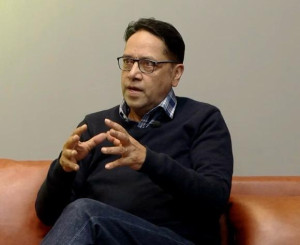Books
Why myths are always relevant
India’s best selling mythologist Devdutt Pattanaik talks about storytelling, queer characters and Pink Tourism.
Aarati Ray
India’s best selling mythologist Devdutt Pattanaik visited Nepal as one of the keynote speakers for Nepal’s first Pink Tourism International Conference, held last week in Kathmandu.
Pattanaik, who is also an illustrator, has penned more than 50 books and over a thousand columns. He writes on the relevance of mythology in modern times, especially in areas of management, governance and leadership.
In an interview with the Post’s Aarati Ray, he shared his views on Pink Tourism in Nepal, LGBTQIA+ rights, his literary works and challenges to mythology.
Which aspect of your work do you feel closest to—mythology, writing, illustrating, or speaking?
I enjoy speaking the most. When you are talking to people, you engage with questions which allows you to explore the subject in depth. Talking to people, and giving lectures is my favourite.
What’s your favourite among your works? What proved to be the most challenging to finish?
I don’t have a favourite book. It’s like a parent being asked to choose their favourite child. However, ‘My Gita’ was quite challenging as I had to explain a very complex idea in simple terms.
How does mythology influence discussions on inclusion and acceptance?
Mythology is how people imagine the world, and we are constantly reimagining ourselves in different ways. A hundred years ago, people believed women should not be educated. Today, these things are changing with our imagination, and expanding with wisdom. That’s what mythology does, it helps you negotiate the way through human insecurities, making it significant in inclusion.
Do mythology, tourism and LGBTQIA+ rights intersect?
Yes, of course. Mythology shapes how we deal with our desires and social expectations. It influences how we interact with our families and communities, who are surprised when our desires do not match theirs. This impacts human relations. There are numerous LGBTQIA+ stories and references in Mahabharata, Tantra, Jataka, Ramayana which are thousands of years old but are not taught or mentioned in the mainstream narrative today.
Mythology also plays an important role in understanding different cultures as well. For instance, Nepali mythology and culture are diverse, drawing from various influences such as Buddhism, Tantrism, Tibetan traditions, Hinduism (particularly Shiva Shakti), Brahminical practices, and local tribes like Kirat. This is the result of Nepali imagination which created art, and architecture unique from other parts of the world. People should come to this land to see these.
For me, I am interested in Tantra-Hinduism, where Hinduism and Buddhism overlap. This synthesis, distinct from Hinduism found in India, makes Nepal a must-visit destination for those interested in mythology and spirituality.
Do you see any changes in how LGBTQIA+ characters are depicted in modern retellings?
I see the focus is more on men’s love today, so lesbian representation is lacking. People also confuse trans queer people with gay and lesbian people. Still, there is definitely more representation in stories today, which is a good shift from what it was 30 years ago. The shift will keep happening as we become more comfortable with ourselves and our sexualities.
What elements of Nepali culture and mythology can attract LGBTQIA+ tourists?
While exploring temples in Nepal, I have seen ancient Tantrik ideas embracing gender and sexual diversity, influenced by strong matriarchal traditions. These concepts are portrayed in Nepal delicately with ‘soul’ in Hindu-Buddhist Tantrik tradition, which is different from Western combative attitudes towards sexuality. This difference and diverse depictions in Nepali temples, art and deities, which show different forms of sexuality, can greatly attract tourists.
Nepal also needs to highlight Tantrik traditions better. India tends to eclipse these ideas but I believe Nepal will show us the way.
How do you respond to critics who claim your LGBTQIA+ interpretations of Indian mythology are too progressive or clash with conservative cultural values?
Well, everyone is entitled to their opinions. Just as that world of old Brahmins who thought they were purer than others is gone, the world of heterosexuality being the only way is also fading.
I embrace nature and Tantra, which teaches us about the fluidity of purusha (spirit) and prakriti (matter). Tantra also taught me to embrace diversity and go beyond right or wrong, as right and wrong are Judeo-Christian traditions alien to the Tantrik world.
What challenges do globalisation and digitalisation pose to storytelling and mythology?
The biggest challenge is that in social media, people are not interested in wisdom. Rather they love drama and climax. Similarly, modern storytellings prefers heroes, villains and victims, while Tantrik stories lack these clear distinctions as it believes in a continuous rhythm of life.
How do you see the current left and right leaning mythologies, political ideologies and discourse?
Left and right leaning mythologies stem from a linear thinking rooted in the Middle East based on the idea of God as a judge. Left wing clings to creating revolution while the right wing clings to imaginary past and futures.
I follow the Tantrik tradition where the world will never be right or left, it will always be oscillating between different ideas over time and space which is why we have the concept of ‘Kala Bhairava’. We move from high to lows, from gunas (qualities)—sattva to rajas to tamas.
This political discourse, with its fixation on left and right ideologies, lacks maturity. You can’t have only the trees that you like in a forest. Nature wants all kinds of trees to exist, and that's true for human genders and sexualities.
What role do artists and intellectuals play in the social justice movement in regions where LGBTQIA+ rights are under threat?
In my writings, I avoid terms like “social justice”, as these are combative and militant ways of functioning that is popular in the West. Kindness and gentleness is what should be expressed through art, and by artists and intellectuals. Nothing is under threat, it's just the world is afraid of change and diversity because diversity can be difficult. We cannot force someone to accept diversity with just posting rules, notices, and doing workshops. We all have to be intellectually kind and understanding from both sides and to ourselves because kindness is on short supply today. We should learn from the dramatic dances of Tantrik gods to assimilate and make everyone comfortable with differences as the world evolves.
What could Nepal hosting the Pink Conference mean for its less queer friendly neighbours?
Nepal’s progressiveness is far ahead of the curve when compared to its neighbours which is admirable. It is showing the world how to be kind. I think Nepal, as the land of Gautam Buddha, needs to continue doing this. Eventually, everyone will all come around to accepting the LGBTQIA+ community, as love always wins over arrogance.
What are your hopes for the future of Pink Tourism in Nepal and India?
Pink Tourism has a long way to go in India, as it not as accepting of queer culture. Our thinking is dominated by old school Brahminical, Christian and Islamic ideologies.
Nepal has progressed a lot in accepting LGBTQIA+ community and I feel this should bring ‘Laxmi’ (wealth and prosperity) to the entrepreneurs here. So, prosperity for Nepal, joy and wisdom for the tourists, and peace to the world is what I hope for.




 14.12°C Kathmandu
14.12°C Kathmandu









%20(1).jpg&w=300&height=200)

